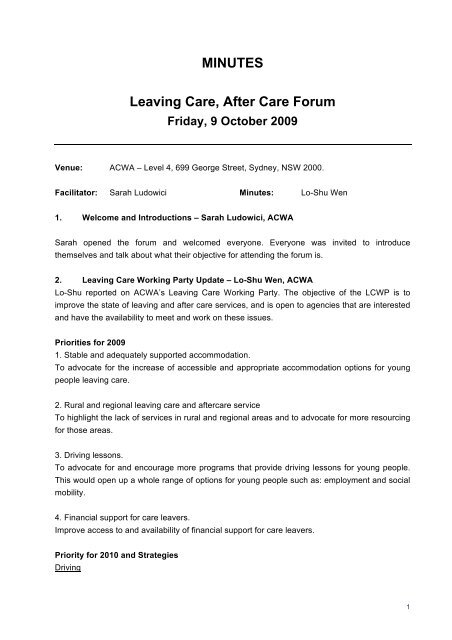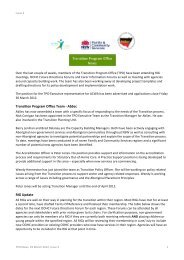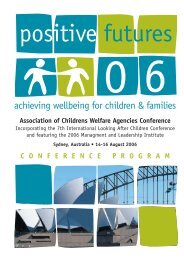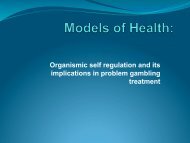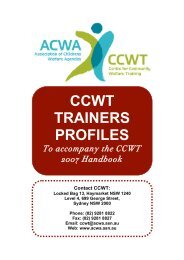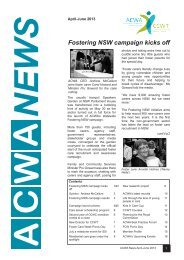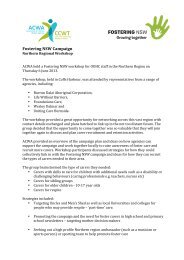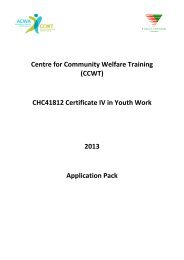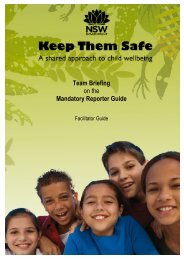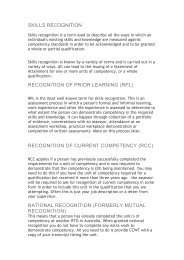Create successful ePaper yourself
Turn your PDF publications into a flip-book with our unique Google optimized e-Paper software.
• Service improvement suggestions related to:o More funds and brokerageo Need for more workerso More consistency and improved systems3. Evaluation of DADHC Leaving <strong>Care</strong> Services – Robyn Edwards, SPRCRobyn from the Social Policy Research Centre advised that they had been approached byDADHC to conduct an evaluation of its leaving care services.Robyn advised that they would also be looking at systems issues; and speaking with a numberof agencies including ARC, AbSec, LCWP.The results will be formulated into a report, which she looks forward to feeding back and sharingwhen complete.4. Northcott Mentoring Service – Jade Strongman, Northcott Disability ServicesJade introduced the new mentoring service at Northcott. Currently they have 5 mentors, and arecurrently recruiting to reach their funded capacity of 11. It is a statewide service and to ensure astatewide reach they will also be using communications technologies such as webcams and e-mentoring.Jade noted that in his observations the transition from DoCS to DADHC where applicable forthose leaving care are not ideal. He commented that it would be better practice for DADHC tobe involved at the point of identification. He also advocated for a client centred approach.The criteria for the program is that the client needs to be identified to join DADHC’s Leaving<strong>Care</strong> program, and not on the basis of mental health. Currently the 5 mentors are based inBallina, Newcastle, Hornsby, Queanbeyan, and the Central West.5. CREATE Foundation – Danielle DomanskiDanielle advised that CREATE produced a report on Transition from Leaving <strong>Care</strong> in 2008 andthis report card and the executive summary are available on the CREATE website. A report hasalso been produced this year and the launch for this is on 18 November.CREATE is the peak body for children in OOHC. CREATE is involved in systemic advocacy andlobbying, and does not provide individual advocacy or case management. CREATE is astatewide service.Danielle spoke about some of the issues in leaving care that young people experience. Thisincluded involving the young person in developing their leaving care plan. This involvementoften seemed tokenistic and short term without any genuine attempt to build rapport with the3
young person over time. The young person should be invited to have a support person if theywant.On other occasions, the young person is not made aware that they have a leaving care plan,and not told about how they can make changes to the plan. Young people are also not toldabout what other services are out there that they could access.6. Keep Them Safe and The Wood Report – Andrew McCallum, ACWAACWA is currently towards the end of delivering the Regional Engagement Tour, which is a 11forum tour around NSW to engage senior managers of both government and non-governmentagencies about the changes that are coming and establishing the notion of a sharedresponsibility for child wellbeing.Some of the changes include new support units such as the Child Wellbeing Unit. Each of thegovernment agencies that are mandatory reporters will have a Child Wellbeing Unit- including:DET, DHS (Community Services, Juvenile Justice, Housing, Ageing Disability and Home <strong>Care</strong>),NSW Health and Police. These units do not provide a service, instead providing support andadvice to the mandatory reporters in those agencies.Among other changes are the initial 12 month trials of the Family Referral Services, in 3locations: Dubbo, Mt Druitt, and Newcastle. These services will provide an alternate pathway forfamilies that need services. Andrew acknowledged one of the issues is that there needs to be athickening of the service system to meet the demand.7. Group DiscussionWhat is the current state of leaving care and after care in NSW?Group 1• Too broad? Leaving care guidelines. Are some people missing out.• Inconsistencies between services’ plans• Communication/delegation of role between Community Services and others involved.Services problematic. Whose responsibility?• Some young people being lost from entire system- no Leaving <strong>Care</strong> Plan.• In practice, an ad hoc response- young person may return and be directed to appropriateservice through community networks- while inconsistent, is it a positive and has resulted insuccess.• Relationship between CSC and service can be huge impact on the LCP/after careachieved for a young person.• Delineation between TILA and leaving care not clear- especially to young person.Budgeting requirements are not equivalent to the young person’s experience of it.Group 24
• Confusion- change of funding• New funding for DADHC leaving care services• Lack of distribution of new funding for after care services• Gaps still for certain target groups eg mental health• Lack of ongoing financial assistance for long term clients• Passionate workers in all services• No CPI increase for funded services• Community Services now recognising need for leaving care plans• Need for consistency across services for leaving care plans with flexibility• Guidelines are not in spirit of the Act• <strong>After</strong> care is seen as an add-on• Under resources system for after care and leaving care• Available funds from DoCS don’t support progression (ie strengths, career, educationetc)• Lack of information/understanding within systemGroup 3• On the research radaro SPRC DADHC leaving careo Ombudsmano CREATE report card• Off the funding radaro Not funded in EOI• TILA increased• On the national framework• Wood recommendations- limitedo Improve information to young persono Improve support to carerso Specialist Community Services workers• Still requires more funds. Discretionary access to services.• Not necessarily responsive to the needs of the client.Group 4• Inconsistent• Sense of powerlessness for young person in planning process• Bland• Discretionary• Under resources• Disorganised/ unplanned• Discriminatory• Inflexible• Mysterious for workers and young people5
• Misinformed/ ill-informed• Antagonistic/ Lacking sensitivity• Negative impact of caseworker turnover• <strong>After</strong> care is becoming recognised• Young people have a voiceWhat should it look like (vision) and what needs to occur to implement vision?Group 1• Seamlesso Clear referral processes and communication between NGOs, DOCS, DADHC,<strong>After</strong> careo Early planningo <strong>After</strong> care to be involved before young person leaves care• Informedo Young person to be informed early of after care and leaving care planningo Consistent resource packs for young people• Government agencies to remove barriers for young person leaving care to accessservices ie apply for housing before 18.• Specialist DoCS workers for leaving care/ after careGroup 2• Funded• Flexible- meet needs• Takes account of person’s circumstances eg young parent• Achieves good outcomes• Equitable across state. Accessible, consistent• Seeing it as prevention• Government and non-government ownershipGroup 3• Young people have secure stable accommodation• To implement the accord• Intense services available and easily accessed for young people• More overlaps- integrated services• Early intervention for leaving care• Flexibility across service provision to enable continuation of worker/young personrelationship• For after care to be fully recognised and valued. (As an early intervention service)• Mentoring across the board for young people.• Education young people of their rights.• For the Dept of Human Services (all services) to work together and prevent gaps.• Equity in funding that truly addresses the individual needs of young people.6
Group 4• Every person leaving OOHC has a leaving care plan• Approval is final- do away with the need to return with every change• A consistent framework (including health/dental) with flexibility for young person’sindividual needs• Entitlements are clearly stated• One stop information gateway- young person, services, community services,government services- available• Recognition that leaving care/ after care is an essential element of the process andeveryone equally invested.• Central regulatory body?• Better resourcing and specific training for workers to assist young people to developindependence.List the most important factors to a well functioning leaving care/ after care system.Group 1• Wellbeing of the young person• Client focused and empowering (strengths-based)• Collaborative• Flexible, user friendly young person’s plan. Creative process.• Well-planned / early planning- sufficient resources.• Consistent and clear• Increased awareness and emphasis on leaving care and after care.• Informed workers and supported in role.Group 2• Good informationo Access too Relevant• Young people need to engage and be empowered in the process• Increased research and continuous improvement• Building good relationships with young person• Celebrate success in the transition process• Involving carers and community• Young people well supported emotionally. Eg preparing for unsupervised familyrelationships.Group 3• Communication between providers and between young person.• Broader societal awareness- government agencies understand issues faced whenleaving care.7
• Housed- stable, affordable• Funding• Oversight by an independent bodyGroup 4• Relationships (Judy Cashmore’s study)o Young person allocated workerso Stability of carers and workers• Truly young person-focused• Adequate funding- reviewed regularly• More after care and leaving care services and workers (including for ‘unfunded’ services)• Government recognises young person as a valued asset.• An integrated system that focuses on the young person• Services that are available when needed and flexible.• Equity of wages for workers in the field (government and non-government)8


